Serving 686 students in grades Kindergarten-5, Miller Elementary School ranks in the top 30% of all schools in California for overall test scores (math proficiency is top 30%, and reading proficiency is top 30%).
The percentage of students achieving proficiency in math is 48% (which is higher than the California state average of 33%). The percentage of students achieving proficiency in reading/language arts is 54% (which is higher than the California state average of 47%).
The student:teacher ratio of 22:1 is higher than the California state level of 21:1.
Minority enrollment is 63% of the student body (majority Hispanic), which is lower than the California state average of 80% (majority Hispanic).
Quick Stats (2025)
- Grades: Kindergarten-5
- Enrollment: 686 students
- Student:Teacher Ratio: 22:1
- Minority Enrollment: 63%
- Overall Testing Rank: Top 30% in CA
- Math Proficiency: 48% (Top 30%)
- Reading Proficiency: 54% (Top 30%)
- Science Proficiency: 45-49% (Top 20%)
- Source: National Center for Education Statistics (NCES), CA Dept. of Education
Top Rankings
Miller Elementary School ranks among the top 20% of public schools in California for:
Category
Attribute
Science Proficiency
Diversity
School Overview
Miller Elementary School's student population of 686 students has declined by 5% over five school years.
The teacher population of 31 teachers has stayed relatively flat over five school years.
Grades Offered
Grades Kindergarten-5
Total Students
686 students
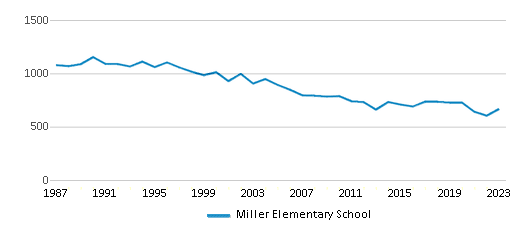
Gender %
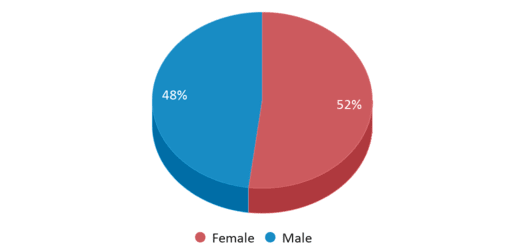
Total Classroom Teachers
31 teachers
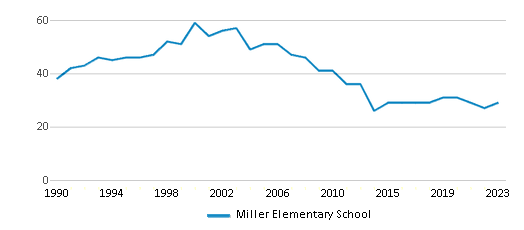
Students by Grade
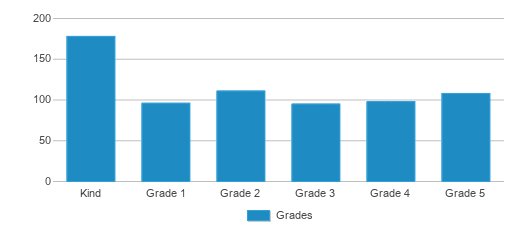
School Calendar
School Rankings
Miller Elementary School ranks within the top 30% of all 9,602 schools in California (based off of combined math and reading proficiency testing data).
The diversity score of Miller Elementary School is 0.73, which is more than the diversity score at state average of 0.63. The school's diversity has stayed relatively flat over five school years.
Overall Testing Rank
#2393 out of 9602 schools
(Top 30%)
(Top 30%)
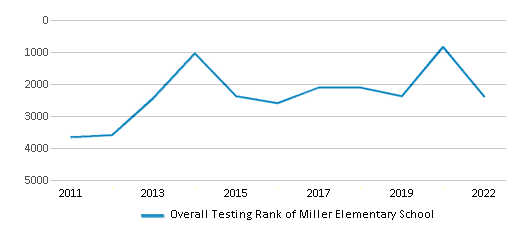
Math Test Scores (% Proficient)
48%
33%

Reading/Language Arts Test Scores (% Proficient)
54%
47%
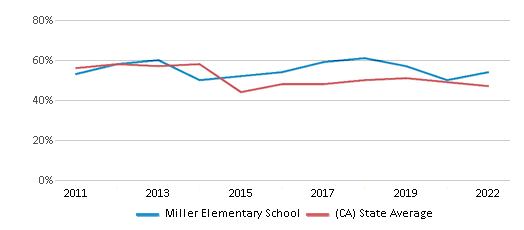
Science Test Scores (% Proficient)
45-49%
29%
Student : Teacher Ratio
22:1
21:1
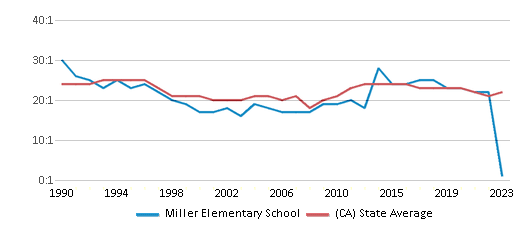
American Indian
n/a
1%
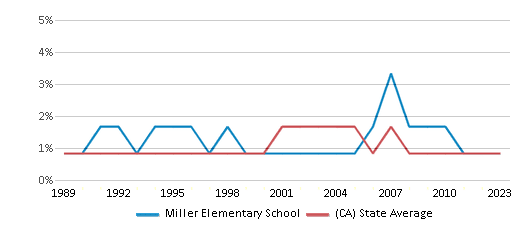
Asian
4%
12%
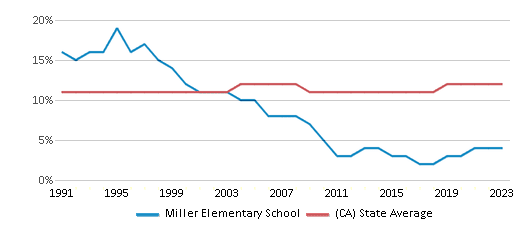
Hispanic
33%
56%
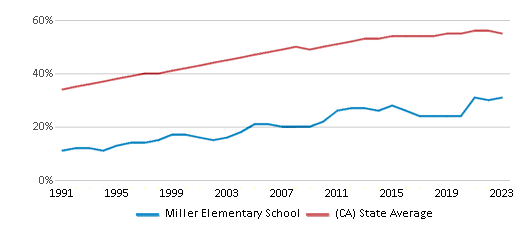
Black
9%
5%

White
37%
20%
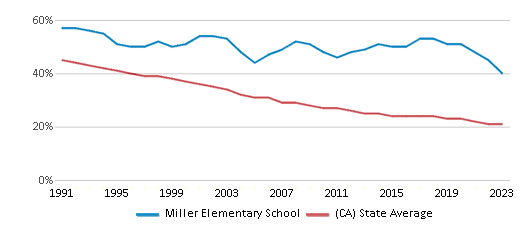
Hawaiian
1%
n/a
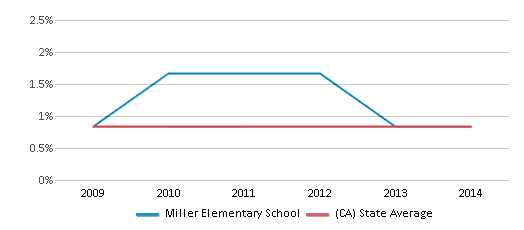
Two or more races
16%
6%
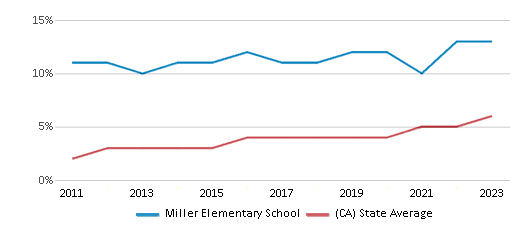
All Ethnic Groups

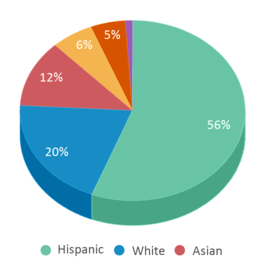
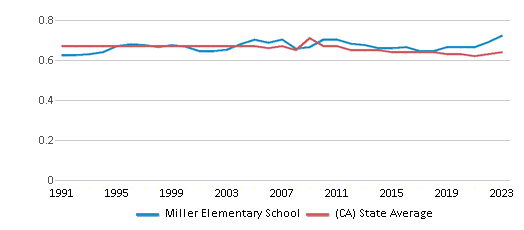
Eligible for Free Lunch
22%
54%

Eligible for Reduced Lunch
44%
8%
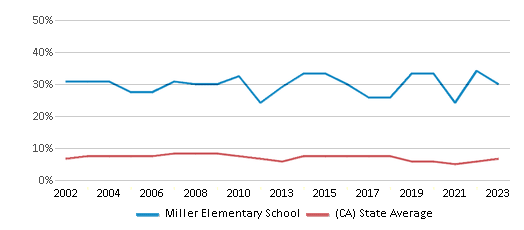
School Statewide Testing
School District Name
Source: National Center for Education Statistics (NCES), CA Dept. of Education
Profile last updated: 02/09/2025
Frequently Asked Questions
What is Miller Elementary School's ranking?
Miller Elementary School is ranked #2393 out of 9,602 schools, which ranks it among the top 30% of public schools in California.
What schools are Miller Elementary School often compared to?
Miller Elementary Schoolis often viewed alongside schools like Tierrasanta Elementary School, Hancock Elementary School by visitors of our site.
What percent of students have achieved state testing proficiency in math and reading?
48% of students have achieved math proficiency (compared to the 33% CA state average), while 54% of students have achieved reading proficiency (compared to the 47% CA state average).
How many students attend Miller Elementary School?
686 students attend Miller Elementary School.
What is the racial composition of the student body?
37% of Miller Elementary School students are White, 33% of students are Hispanic, 16% of students are Two or more races, 9% of students are Black, 4% of students are Asian, and 1% of students are Hawaiian.
What is the student:teacher ratio of Miller Elementary School?
Miller Elementary School has a student ration of 22:1, which is higher than the California state average of 21:1.
What grades does Miller Elementary School offer ?
Miller Elementary School offers enrollment in grades Kindergarten-5
What school district is Miller Elementary School part of?
Miller Elementary School is part of San Diego Unified School District.
School Reviews
5 1/17/2018
I had 2 children at Miller and they had a great experience. My youngest did kinder and part of 1st grade before moving and both teachers were great! My other daughter did 3rd, 4th and part of 5th grade before moving and her teachers were wonderful. I loved the teachers and the school staff. My kids did very well there academically. We were sad to go.
2 10/31/2011
My son has been going to this school since kindergarten and he is now in third grade. He has a learning disability and trying to get an IEP is to hard. We have been fighting for two years and still getting no where. His teacher this year is not capable of teaching a child with dyslexia, she not willing to work with the parents and she yells at the students. I spoke with the principal and she is no better than her staff.
2 9/1/2011
My daughter transfefred halfway through the year to Miller. They were so far ahead from her previous school and would not get her any help to catch up. The teacher was very rude not only to my daughter but to me as well. I talked to the teacher many times and still no solution was made. Her last report card said that she has no respect for other people property when I well know that my daughter knows better and is very sweet shy girl that is not capable of that.
Review Miller Elementary School. Reviews should be a few sentences in length. Please include any comments on:
- Quality of academic programs, teachers, and facilities
- Availability of music, art, sports and other extracurricular activities
Recent Articles

What Is A Charter School?
Explore the world of charter schools in this comprehensive guide. Learn about their history, how they operate, and the pros and cons of this educational innovation. Discover key facts about charter schools, including admission policies, demographics, and funding, as well as what to look for when considering a charter school for your child.

10 Reasons Why High School Sports Benefit Students
Discover the 10 compelling reasons why high school sports are beneficial for students. This comprehensive article explores how athletics enhance academic performance, foster personal growth, and develop crucial life skills. From improved fitness and time management to leadership development and community representation, learn why participating in high school sports can be a game-changer for students' overall success and well-being.

February 05, 2025
Understanding the U.S. Department of Education: Structure, Impact, and EvolutionWe explore how the Department of Education shapes American education, from its cabinet-level leadership to its impact on millions of students, written for general audiences seeking clarity on this vital institution.





